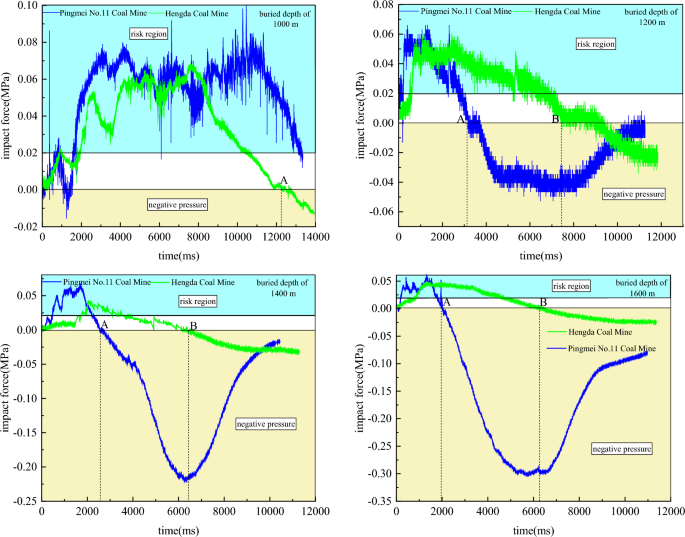Macroscopic fracture mechanism of coal body and evolution characteristics
During the outburst process, the gas wrapped fragmentized pulverized coal thrown to form the impact air flow, which squeezes the air in the roadway. After multiple superposition propagation, the shock wave is finally formed. The impact air flow attenuates through the barrier of the outburst weak surface. The shock wave attenuates with the increase of the outburst distance. This leads to a small impact force value at the distal end of the roadway, which cannot well reflect the coal fracture in the pressure chamber and the release amount of outburst energy. Therefore, the impact force sensor is installed at the side of the roadway 1 m away from the outburst port to monitor the impact force evolution law of the same measure locations at different buried depths during the test.
Evolution characteristics of impact force at different buried depths
In order to further study the evolution characteristics of impact force, the outburst coal seam of Pingmei No. 11 Coal Mine and Sunjiawan high gas coal seam of Hengda Coal Mine were taken as the research objects, and the impact force of simulated buried depth of 1000 m, 1200 m, 1400 m and 1600 m were monitored (Fig. 8).
The evolution law of impact force at different simulated buried depths of the same measure locations after outburst are as follows:
-
(1)
After the impact force rises to the maximum value, the fluctuation intensity is large and the time is long at the simulated buried depth of 1000 m. According to the “deep” scheme, it is considered that the critical depth of the two coal mines can be defined as the simulated buried depth of 1000 m. The buried depth is simulated from 1000 to 1600 m, and the change of impact force follows the law of “fast rise-peak value-slow decrease”. With the increase of simulated buried depth, the ground stress increases gradually, the critical gas pressure required for outburst decreases, and the migration time of broken pulverized coal in roadway is shortened. With the increase of simulated buried depth, the peak value of impact force decreases and the number of peaks decreases. It shows that high ground stress and low gas pressure can hinder the propagation frequency of impact force in roadway under deep work conditions. Therefore, in deep coal mining, the gas extraction should be paid attention to. The purpose of effectively reducing the damage caused by the impact force to the underground mining space and equipment for producing and ensuring the safety of the staff will be achieved.
-
(2)
After the outburst, the impact force in the roadway obviously has a negative pressure, which causes the pulverized coal collection bag at the end of the roadway to be sucked into the roadway. The negative pressure increases with the increase of simulated buried depth. When the simulated buried depth reaches a certain value, the suction generated by the negative pressure may gradually be greater than the impact force generated by the outburst. It shows that the staff is more dangerous under the deep work conditions. In addition to the harm caused by the impact force, the staff may also be sucked into the deep part of the roadway and buried. Therefore, with the increase of mining depth and intensity, in order to ensure the safety of underground workers, it has become an inevitable trend to study the mechanism of deep outburst.
-
(3)
Point A indicates the occurring time of negative pressure in Pingmei No. 11 Coal Mine, and point B indicates the occurring time of negative pressure in Hengda Coal Mine. When the simulated buried depth is 1000 m, there is no obvious negative pressure in Pingmei No. 11 Coal Mine. The time of negative pressure in Hengda Coal Mine is late, which is 12,303 ms. When the simulated burial depths are 1200 m, 1400 m and 1600 m respectively, the negative pressure time of Pingmei No. 11 Coal Mine is 3160 ms, 2554 ms and 2020 ms respectively, and the negative pressure time of Hengda Coal Mine is 7766 ms, 6411 ms and 6369 ms respectively. With the increase of simulated buried depth, the occurring times of negative pressure in the Pingmei No. 11 Coal Mine and Hengda Coal Mine are advanced, the critical gas pressure decreases, and the propagation time of impact force in roadway becomes shorter. It shows that the strength and duration of impact force are determined by the gas pressure.
…
Read More: Macroscopic fracture mechanism of coal body and evolution characteristics


